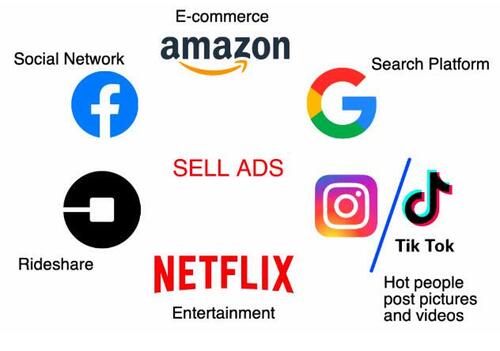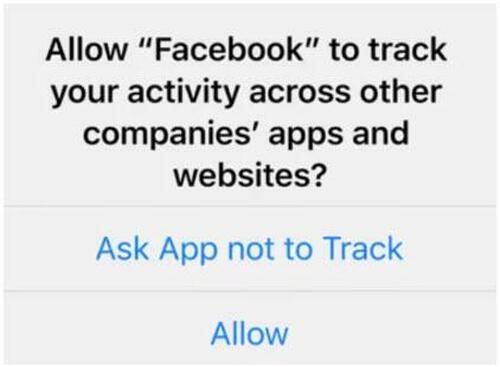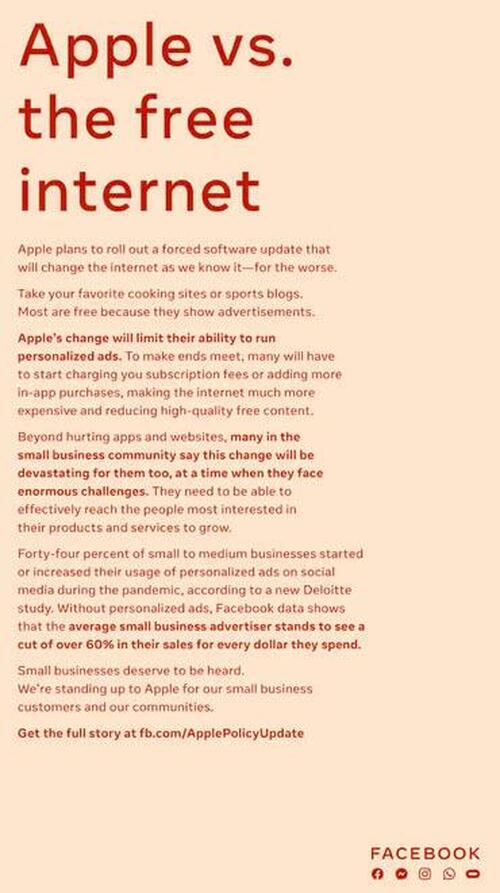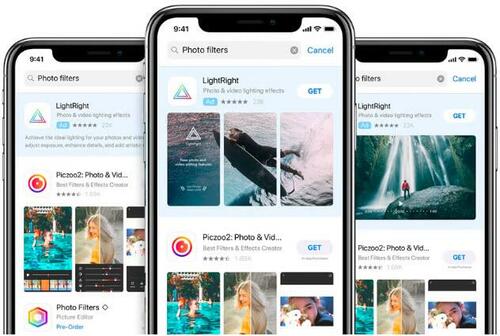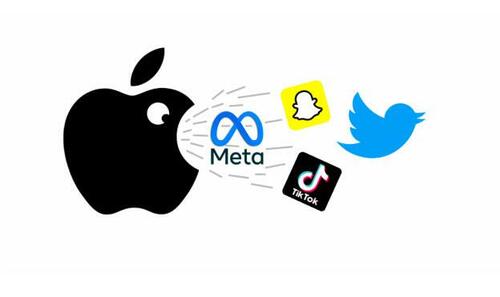
Authored by Jack Raines via Young Money,
Season 19 of the popular comedy television show "South Park" premiered in Fall 2015. If you are an avid South Park fan, you may remember this season for its introduction of "PC Principal," an over-the-top social justice warrior/elementary school principal.
However, there was an underlying sinister plot to the entire season as well: Internet ads had become sentient, and they were taking over the world by manipulating human behavior.
In the clip linked below, Eric Cartman gives a detailed monologue about the rise of ads from simple television advertisements to cleverly disguised internet ads.
The idea that internet ads are sentient beings trying to wipe out mankind is as comical as it is preposterous, but Cartman's timeline of ad development is surprisingly accurate. A little bit too accurate.
On a long enough timeline, every large company eventually becomes an ad network.
Don't believe me? Facebook (Meta), originally a social network that allowed friends to connect over the internet, built a $500B business as an advertisement platform.
Alphabet, the parent company of both Google and YouTube, generated $55B in ad revenue in Q1 2022.
Amazon may very well be the fastest-growing ad network in the world right now.
Search for literally anything on Amazon. Maybe... vacuum cleaners. Check out the results. At first glance, it's just a list of products, right? Look closely in the bottom-right corner:
Do you see it?
Tricky tricky, Hoover Vacuum Cleaners! These sponsored product placements are, in the world of advertising, prime real estate. Amazon is the one-stop shop to purchase literally anything online, and Amazon has more data on consumer product purchases and inquiries than any other e-commerce platform.
A gold mine of consumer data and millions of page views per day means that Amazon can charge top dollar for these ad placements. And charge top dollar they have. In 2021, Amazon's ads were worth more than the entire global newspaper industry.
I wondered when Amazon would start disclosing advertising revenue. Answer: $31bn in 2021 - roughly the same size as the entire global newspaper industry.
— Benedict Evans (@benedictevans) February 3, 2022
AWS produced $18.5bn operating income - it's plausible that the ad business is now more profitable. pic.twitter.com/MCq3zjp3Kc
This is a feature, not a bug, of well-scaled businesses. While we traditionally think of "advertising" as a media-focused activity primarily allocated to television, print, and radio, advertisers aren't worried about the medium. They are concerned with the reachable audience.
Pre-internet, massive audiences were only reachable through traditional media channels. Post-internet, massive audiences are reachable... everywhere. In scaling billion (and trillion) dollar businesses, the world's biggest tech companies have all built large, engaged audiences.
These large, engaged audiences are extremely valuable.
Facebook built an audience of friends who want to connect. Amazon built an audience of online shoppers. Google built an audience of people who need to find information right now.
You get the idea.
No one sets out to build an ad business from scratch, but every business, at a certain scale, eventually sells advertisements as a byproduct of its own success. If advertisers are willing to pay thousands, millions, or billions for access to your audience, it's a no-brainer.
Last quarter, Netflix suffered its first subscriber loss in more than a decade. The result? They announced a partnership with Microsoft for an upcoming lower-priced, ad-supported subscription. Growth stalled on their primary product, may as well sell ads.
With large enough audiences, individuals can become ad platforms too. Look no further than TikTok and Instagram stars for evidence. Fitness junkies sell supplements and athletic clothing. Travel influencers shout out different hostels and vacation spots.
Even Uber also offers car-top advertisements through its "Out of Home" program, which lets your local barbershop buy ad space on the roof of your 3 AM ride home.
On a long enough timeline, regardless of the business model, everyone sells ads.
Yet for a while, one tech giant largely avoided the ad game altogether: Apple. Despite the rest of the tech giants building advertisement empires, Apple remained focused on its hardware and software products.
While Apple has long included app store advertisements at the top of its search results, its 2019 ad revenue was a "measly" $500M.
In comparison, Facebook did $69B in 2019 ad revenue, and Amazon did $13B in ad revenue in the same year.
However, everything changed in April 2021 when Apple launched its iOS 14.5. While iOS 14.5 brought several updates, the biggest by far was an overhauled stance on user privacy. With this update, targeted advertising became much more difficult.
Before 14.5, 3rd-party sites (read: Facebook and Google) could access your data through software development kits (SDKs) and application programming interfaces (APIs) embedded in different applications. I could try to explain the intricacies of this, but I'm not a tech guy.
This Vox article, however, does a fantastic job of explaining what this process looked like.
For instance, if a developer wants to let users sign into an app with their Facebook accounts, they’d want Facebook’s Login SDK. If their app needs maps or map data, they could use Google’s Map SDK. Without SDKs, developers would have to build those things entirely from scratch. That’s time-consuming and could be beyond a small developer’s abilities or budgets. SDKs may also help apps communicate with third parties through what is called an application programming interface, or API. Using the Facebook Login SDK as an example again, the SDK helps the developer build and implement the sign-in feature in their app, while the API allows the app and Facebook to communicate with each other so the sign-in can happen...
Here’s where the tracking comes in. The data your device’s app sends to a third party can be used to build a profile of the app’s user, which advertisers can then use for targeted ads.
Because Facebook and Google sign-ins were on pretty much every application, these sites had access through their APIs to a ton of consumer information. This information was then used by these sites to build a profile of "you", which would be used to share more relevant ads with you when you were on these sites.
Your first reaction is probably "tracking is bad!" because we consumers tend to value our privacy. However, this "tracking" provides you with more relevant ads, and it provides many businesses with higher sales conversions.
If I'm planning a ski trip, and I'm researching different ski resorts, it would be much better for me, the consumer, to receive social media ads for ski rentals and lift tickets, not swimsuit discounts.
Because of the accuracy of these ads (especially Facebook ads), many small businesses, such as e-commerce shops on Shopify, would use Facebook ads to drive traffic. These ads were extremely effective for generating high conversion rates at low costs, making them a primary marketing method for online businesses.
Before 14.5, iPhone users could technically opt out of API tracking, but you had to dig deep into your settings for the switch. Since the release of 14.5, you have seen this pop-up window anytime an app wants access to your information.
This change, which Apple calls App Tracking Transparency (ATT), has been quite effective. Now, only ~20% of users opt-in to 3rd-party tracking.
Facebook was, of course, furious. Mark Zuckerberg launched a massive PR campaign saying that Apple was attacking the "free internet", and small businesses could see a 60% reduction in sales per dollar spent on social media ads.
Facebook certainly wasn't launching this campaign out of the goodness of their hearts; their bottom line would be materially impacted by less effective targeted ads, as business spend on these ads would drop. However, Zuck and Co still make a convincing argument: small business sales would be impacted.
Tim Cook didn't back down. In fact, he painted Apple as a guardian of consumer data.
“Technology does not need vast troves of personal data, stitched together across dozens of websites and apps, in order to succeed,” Cook said. “Advertising existed and thrived for decades without it. And we’re here today because the path of least resistance is rarely the path of wisdom. If a business is built on misleading users, on data exploitation, on choices that are no choices at all, then it does not deserve our praise. It deserves reform.”
And Cook makes a good argument! The case for minimizing the tracking capabilities of technology companies in the name of consumer privacy is respectable.
But was Apple really concerned with protecting privacy, or was it looking to kneecap the competition?
AppsFlyer released an advertising Performance Index that covered the second half of 2021, and guess who was the best ad network for mobile marketers on iPhones and iPads?
Apple Search Ads!
These are what you see in the App Store at the top of search results.
Apple’s ad network has significantly expanded since Apple changed marketing practices, hitting 60% of all its business from the first half of 2020 in just seven weeks in 2021.
Consider me shocked, and I mean shocked, that after implementing "privacy updates" that hurt other sites like Facebook Meta, Apple crushed its 2020 numbers in a fraction of the time in 2021.
Why the outperformance? Because of a quirk with iOS 14.5. This update prevented the sharing of information between different parties (i.e. Facebook accessing data from other apps). It did not prevent the exchange of information within a single platform.
Since iPhone owners are Apple customers, and Apple Search Ads is part of Apple, Apple Search Ads can use different standards and methodologies to identify the right people for marketers’ ads.
ASA shows ads primarily in the App Store, and if you’re there, you’re likely there to search for and install apps. If Apple can get the right ad in front of you, you’re very likely to click on it and install it.
Tl;dr: Apple can gather and share your data with itself, but different parties can't share your data with each other.
Pretty convenient outcome from this privacy update, considering that 113M+ Americans have iPhones, isn't it?
And to top everything off, earlier this week, Apple's VP of Advertising, Todd Teresi, said that he wants Apple's ad business to increase from $4B annually to "double digits."
So to recap the whole thing, Apple made a new rule that makes it pretty much impossible for companies to share consumer data with each other, and they publicly vilified "data sharing" to paint themselves as a guardian of consumer interests.
Meanwhile, they quietly benefited from their own rules that they don't have to abide by, thanks to having a near monopoly on cell phone usage in the US.
While the FTC has been busy shutting down every Mark Zuckerberg acquisition under the sun, Apple has quietly positioned itself to dominate the online advertising market of the 2020s.
Shoutout to evil emperor Tim Cook for the power play of a lifetime.
Calls on $AAPL.
* * *
Welcome to Young Money! If you want to join 15,220 other readers learning about finances and career navigation, subscribe here. You can check out my other articles and follow me on Twitter too!
Authored by Jack Raines via Young Money,
Season 19 of the popular comedy television show “South Park” premiered in Fall 2015. If you are an avid South Park fan, you may remember this season for its introduction of “PC Principal,” an over-the-top social justice warrior/elementary school principal.
However, there was an underlying sinister plot to the entire season as well: Internet ads had become sentient, and they were taking over the world by manipulating human behavior.
In the clip linked below, Eric Cartman gives a detailed monologue about the rise of ads from simple television advertisements to cleverly disguised internet ads.
The idea that internet ads are sentient beings trying to wipe out mankind is as comical as it is preposterous, but Cartman’s timeline of ad development is surprisingly accurate. A little bit too accurate.
On a long enough timeline, every large company eventually becomes an ad network.
Don’t believe me? Facebook (Meta?), originally a social network that allowed friends to connect over the internet, built a $500B business as an advertisement platform.
Alphabet, the parent company of both Google and YouTube, generated $55B in ad revenue in Q1 2022.
Amazon may very well be the fastest-growing ad network in the world right now.
Search for literally anything on Amazon. Maybe… vacuum cleaners. Check out the results. At first glance, it’s just a list of products, right? Look closely in the bottom-right corner:
Do you see it?
Tricky tricky, Hoover Vacuum Cleaners! These sponsored product placements are, in the world of advertising, prime real estate. Amazon is the one-stop shop to purchase literally anything online, and Amazon has more data on consumer product purchases and inquiries than any other e-commerce platform.
A gold mine of consumer data and millions of page views per day means that Amazon can charge top dollar for these ad placements. And charge top dollar they have. In 2021, Amazon’s ads were worth more than the entire global newspaper industry.
I wondered when Amazon would start disclosing advertising revenue. Answer: $31bn in 2021 – roughly the same size as the entire global newspaper industry.
AWS produced $18.5bn operating income – it’s plausible that the ad business is now more profitable. pic.twitter.com/MCq3zjp3Kc— Benedict Evans (@benedictevans) February 3, 2022
This is a feature, not a bug, of well-scaled businesses. While we traditionally think of “advertising” as a media-focused activity primarily allocated to television, print, and radio, advertisers aren’t worried about the medium. They are concerned with the reachable audience.
Pre-internet, massive audiences were only reachable through traditional media channels. Post-internet, massive audiences are reachable… everywhere. In scaling billion (and trillion) dollar businesses, the world’s biggest tech companies have all built large, engaged audiences.
These large, engaged audiences are extremely valuable.
Facebook built an audience of friends who want to connect. Amazon built an audience of online shoppers. Google built an audience of people who need to find information right now.
You get the idea.
No one sets out to build an ad business from scratch, but every business, at a certain scale, eventually sells advertisements as a byproduct of its own success. If advertisers are willing to pay thousands, millions, or billions for access to your audience, it’s a no-brainer.
Last quarter, Netflix suffered its first subscriber loss in more than a decade. The result? They announced a partnership with Microsoft for an upcoming lower-priced, ad-supported subscription. Growth stalled on their primary product, may as well sell ads.
With large enough audiences, individuals can become ad platforms too. Look no further than TikTok and Instagram stars for evidence. Fitness junkies sell supplements and athletic clothing. Travel influencers shout out different hostels and vacation spots.
Even Uber also offers car-top advertisements through its “Out of Home” program, which lets your local barbershop buy ad space on the roof of your 3 AM ride home.
On a long enough timeline, regardless of the business model, everyone sells ads.
Yet for a while, one tech giant largely avoided the ad game altogether: Apple. Despite the rest of the tech giants building advertisement empires, Apple remained focused on its hardware and software products.
While Apple has long included app store advertisements at the top of its search results, its 2019 ad revenue was a “measly” $500M.
In comparison, Facebook did $69B in 2019 ad revenue, and Amazon did $13B in ad revenue in the same year.
However, everything changed in April 2021 when Apple launched its iOS 14.5. While iOS 14.5 brought several updates, the biggest by far was an overhauled stance on user privacy. With this update, targeted advertising became much more difficult.
Before 14.5, 3rd-party sites (read: Facebook and Google) could access your data through software development kits (SDKs) and application programming interfaces (APIs) embedded in different applications. I could try to explain the intricacies of this, but I’m not a tech guy.
This Vox article, however, does a fantastic job of explaining what this process looked like.
For instance, if a developer wants to let users sign into an app with their Facebook accounts, they’d want Facebook’s Login SDK. If their app needs maps or map data, they could use Google’s Map SDK. Without SDKs, developers would have to build those things entirely from scratch. That’s time-consuming and could be beyond a small developer’s abilities or budgets. SDKs may also help apps communicate with third parties through what is called an application programming interface, or API. Using the Facebook Login SDK as an example again, the SDK helps the developer build and implement the sign-in feature in their app, while the API allows the app and Facebook to communicate with each other so the sign-in can happen…
Here’s where the tracking comes in. The data your device’s app sends to a third party can be used to build a profile of the app’s user, which advertisers can then use for targeted ads.
Because Facebook and Google sign-ins were on pretty much every application, these sites had access through their APIs to a ton of consumer information. This information was then used by these sites to build a profile of “you”, which would be used to share more relevant ads with you when you were on these sites.
Your first reaction is probably “tracking is bad!” because we consumers tend to value our privacy. However, this “tracking” provides you with more relevant ads, and it provides many businesses with higher sales conversions.
If I’m planning a ski trip, and I’m researching different ski resorts, it would be much better for me, the consumer, to receive social media ads for ski rentals and lift tickets, not swimsuit discounts.
Because of the accuracy of these ads (especially Facebook ads), many small businesses, such as e-commerce shops on Shopify, would use Facebook ads to drive traffic. These ads were extremely effective for generating high conversion rates at low costs, making them a primary marketing method for online businesses.
Before 14.5, iPhone users could technically opt out of API tracking, but you had to dig deep into your settings for the switch. Since the release of 14.5, you have seen this pop-up window anytime an app wants access to your information.
This change, which Apple calls App Tracking Transparency (ATT), has been quite effective. Now, only ~20% of users opt-in to 3rd-party tracking.
Facebook was, of course, furious. Mark Zuckerberg launched a massive PR campaign saying that Apple was attacking the “free internet”, and small businesses could see a 60% reduction in sales per dollar spent on social media ads.
Facebook certainly wasn’t launching this campaign out of the goodness of their hearts; their bottom line would be materially impacted by less effective targeted ads, as business spend on these ads would drop. However, Zuck and Co still make a convincing argument: small business sales would be impacted.
Tim Cook didn’t back down. In fact, he painted Apple as a guardian of consumer data.
“Technology does not need vast troves of personal data, stitched together across dozens of websites and apps, in order to succeed,” Cook said. “Advertising existed and thrived for decades without it. And we’re here today because the path of least resistance is rarely the path of wisdom. If a business is built on misleading users, on data exploitation, on choices that are no choices at all, then it does not deserve our praise. It deserves reform.”
And Cook makes a good argument! The case for minimizing the tracking capabilities of technology companies in the name of consumer privacy is respectable.
But was Apple really concerned with protecting privacy, or was it looking to kneecap the competition?
AppsFlyer released an advertising Performance Index that covered the second half of 2021, and guess who was the best ad network for mobile marketers on iPhones and iPads?
Apple Search Ads!
These are what you see in the App Store at the top of search results.
Apple’s ad network has significantly expanded since Apple changed marketing practices, hitting 60% of all its business from the first half of 2020 in just seven weeks in 2021.
Consider me shocked, and I mean shocked, that after implementing “privacy updates” that hurt other sites like Facebook Meta, Apple crushed its 2020 numbers in a fraction of the time in 2021.
Why the outperformance? Because of a quirk with iOS 14.5. This update prevented the sharing of information between different parties (i.e. Facebook accessing data from other apps). It did not prevent the exchange of information within a single platform.
Since iPhone owners are Apple customers, and Apple Search Ads is part of Apple, Apple Search Ads can use different standards and methodologies to identify the right people for marketers’ ads.
ASA shows ads primarily in the App Store, and if you’re there, you’re likely there to search for and install apps. If Apple can get the right ad in front of you, you’re very likely to click on it and install it.
Tl;dr: Apple can gather and share your data with itself, but different parties can’t share your data with each other.
Pretty convenient outcome from this privacy update, considering that 113M+ Americans have iPhones, isn’t it?
And to top everything off, earlier this week, Apple’s VP of Advertising, Todd Teresi, said that he wants Apple’s ad business to increase from $4B annually to “double digits.”
So to recap the whole thing, Apple made a new rule that makes it pretty much impossible for companies to share consumer data with each other, and they publicly vilified “data sharing” to paint themselves as a guardian of consumer interests.
Meanwhile, they quietly benefited from their own rules that they don’t have to abide by, thanks to having a near monopoly on cell phone usage in the US.
While the FTC has been busy shutting down every Mark Zuckerberg acquisition under the sun, Apple has quietly positioned itself to dominate the online advertising market of the 2020s.
Shoutout to evil emperor Tim Cook for the power play of a lifetime.
Calls on $AAPL.
* * *
Welcome to Young Money! If you want to join 15,220 other readers learning about finances and career navigation, subscribe here. You can check out my other articles and follow me on Twitter too!




